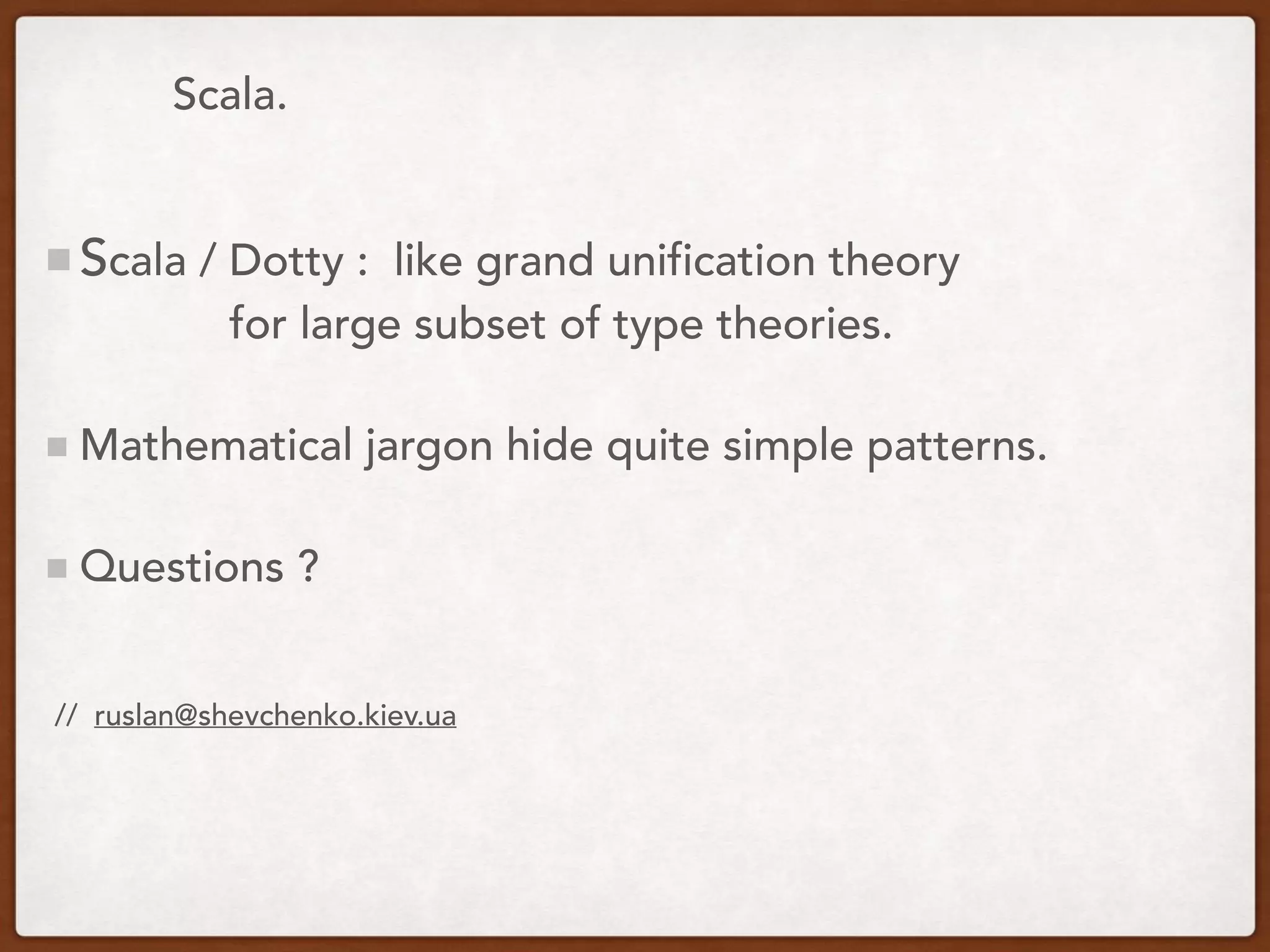This document provides a dictionary of scala programming concepts including definitions of common jargon like ADT, typeclasses, extension methods, and call-by semantics. It defines ADT as algebraic data types, which were introduced in languages like Algol 60 and ML, and pattern matching which allows decomposing ADT values. Typeclasses are defined as rules for types like equality, with instances providing implementations. Extension methods and implicit conversions add methods to types via implicit parameters. Call-by-name and call-by-need semantics are discussed in relation to lazy evaluation.
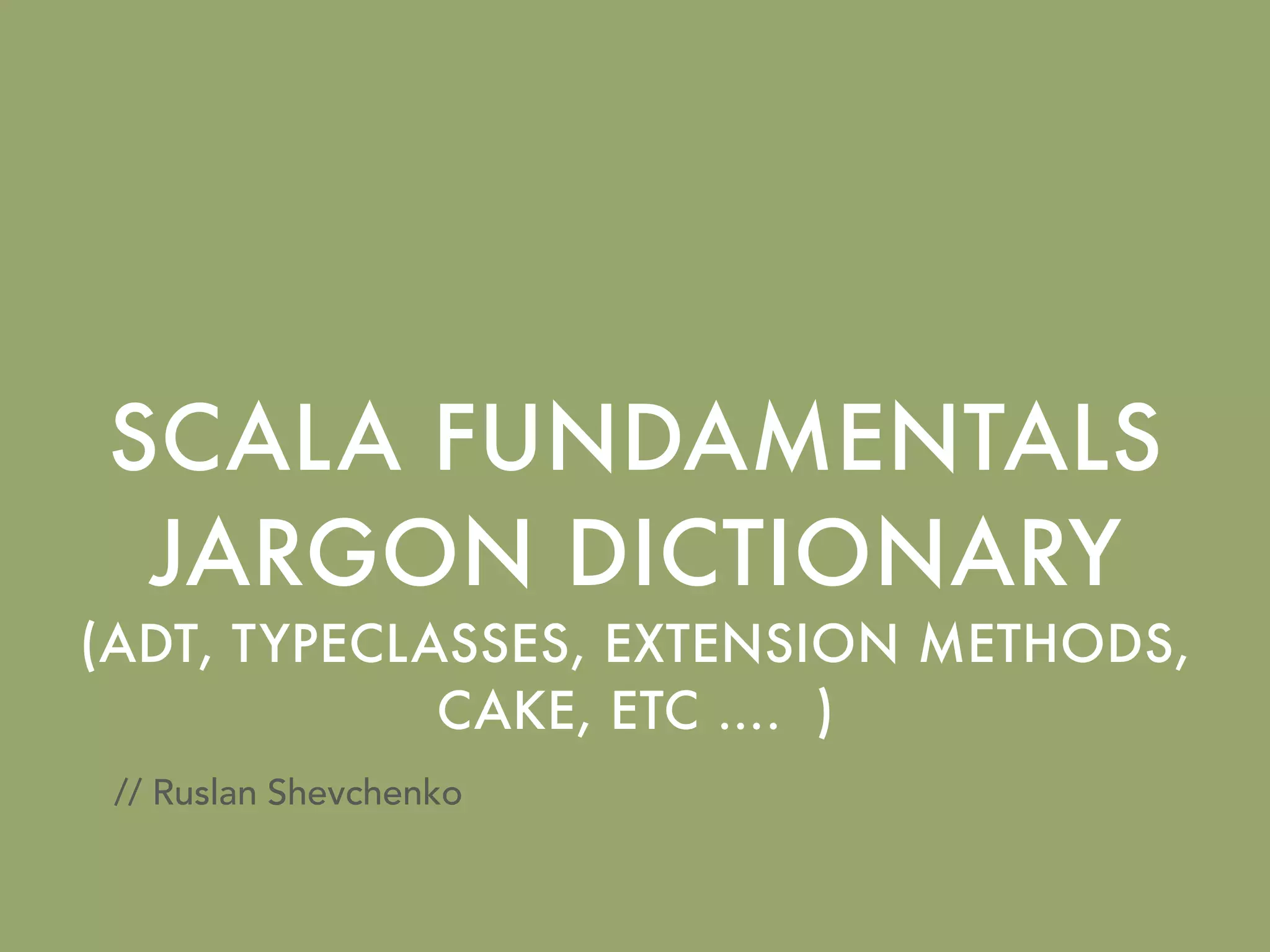
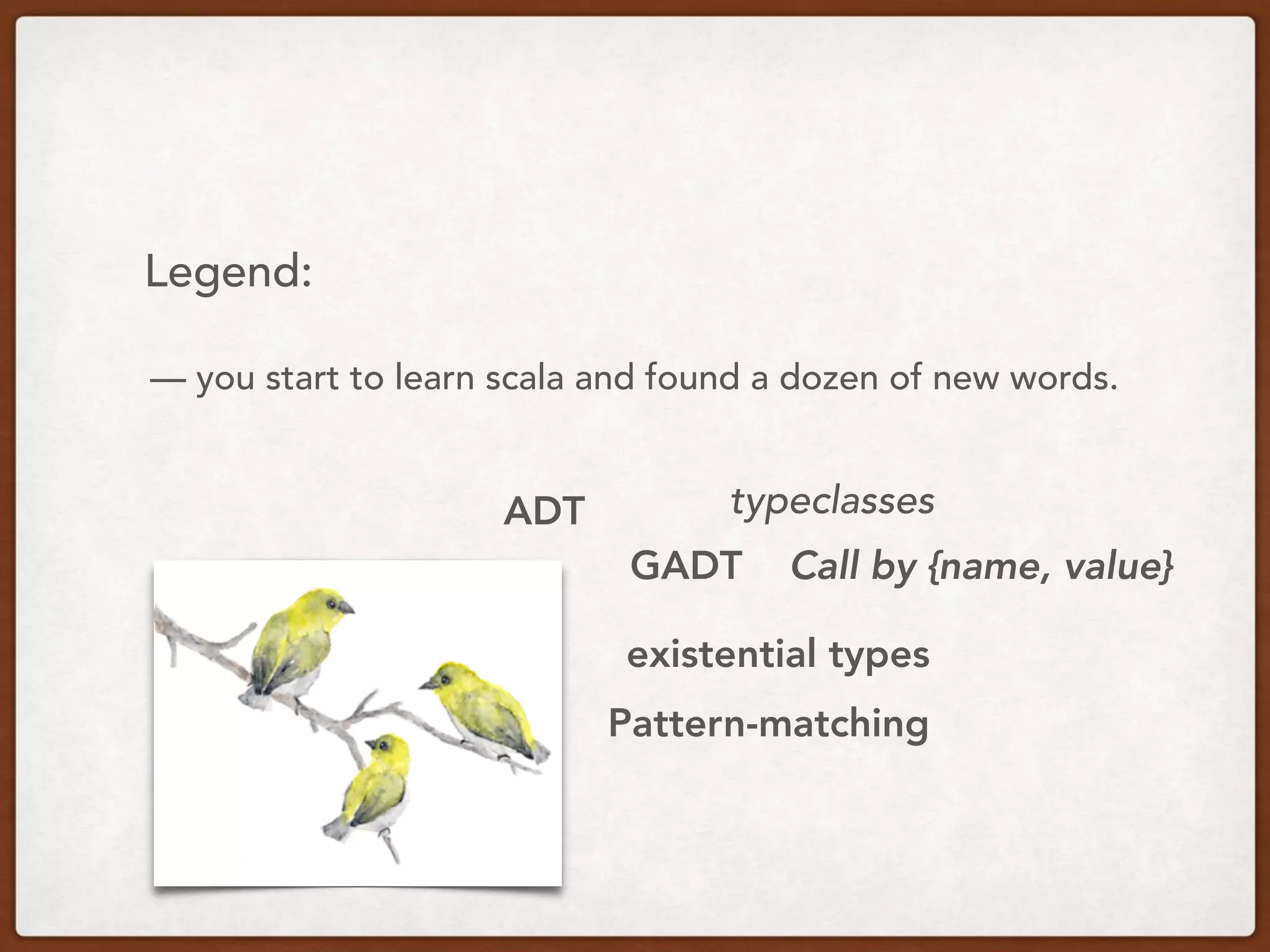
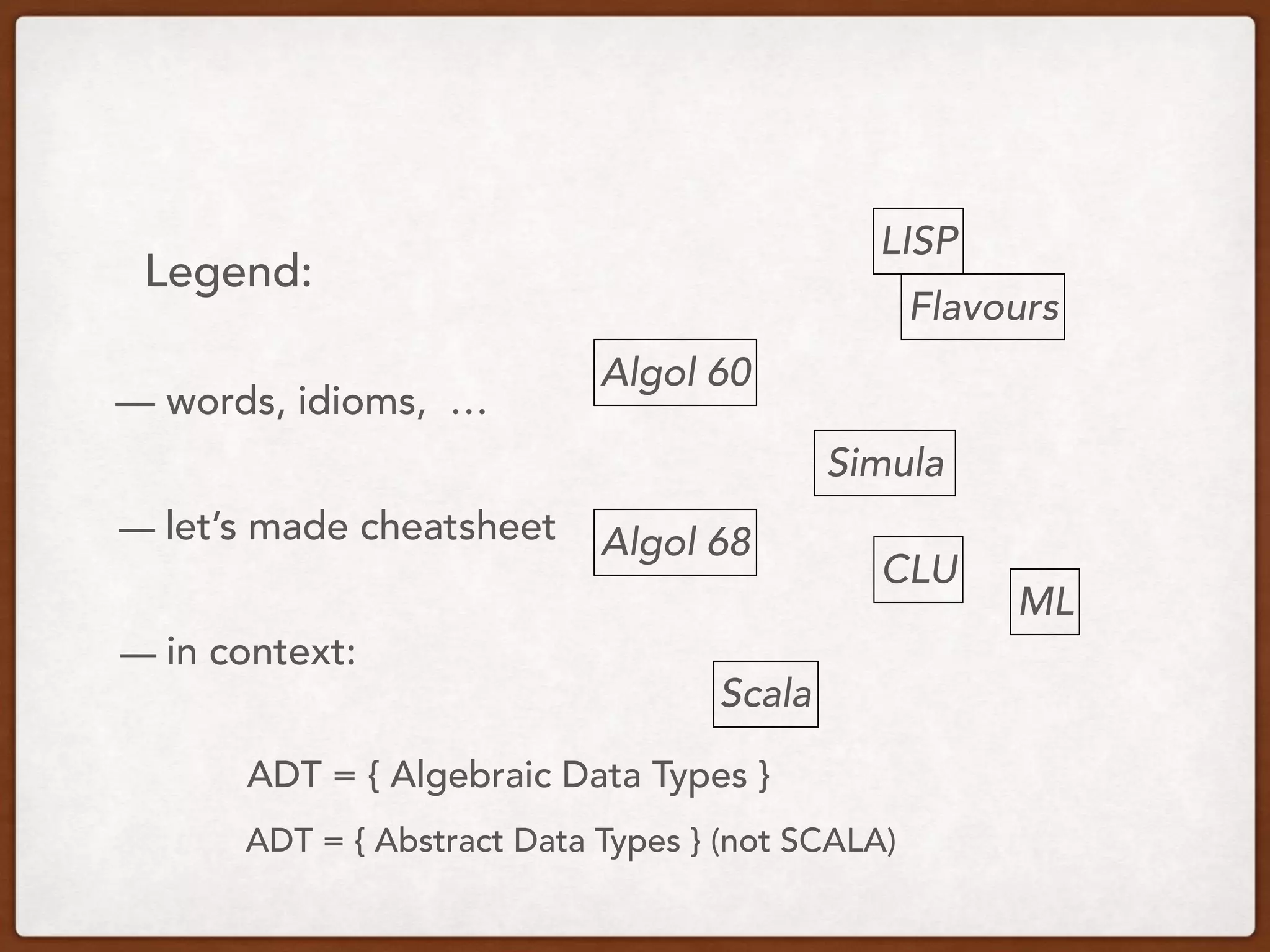
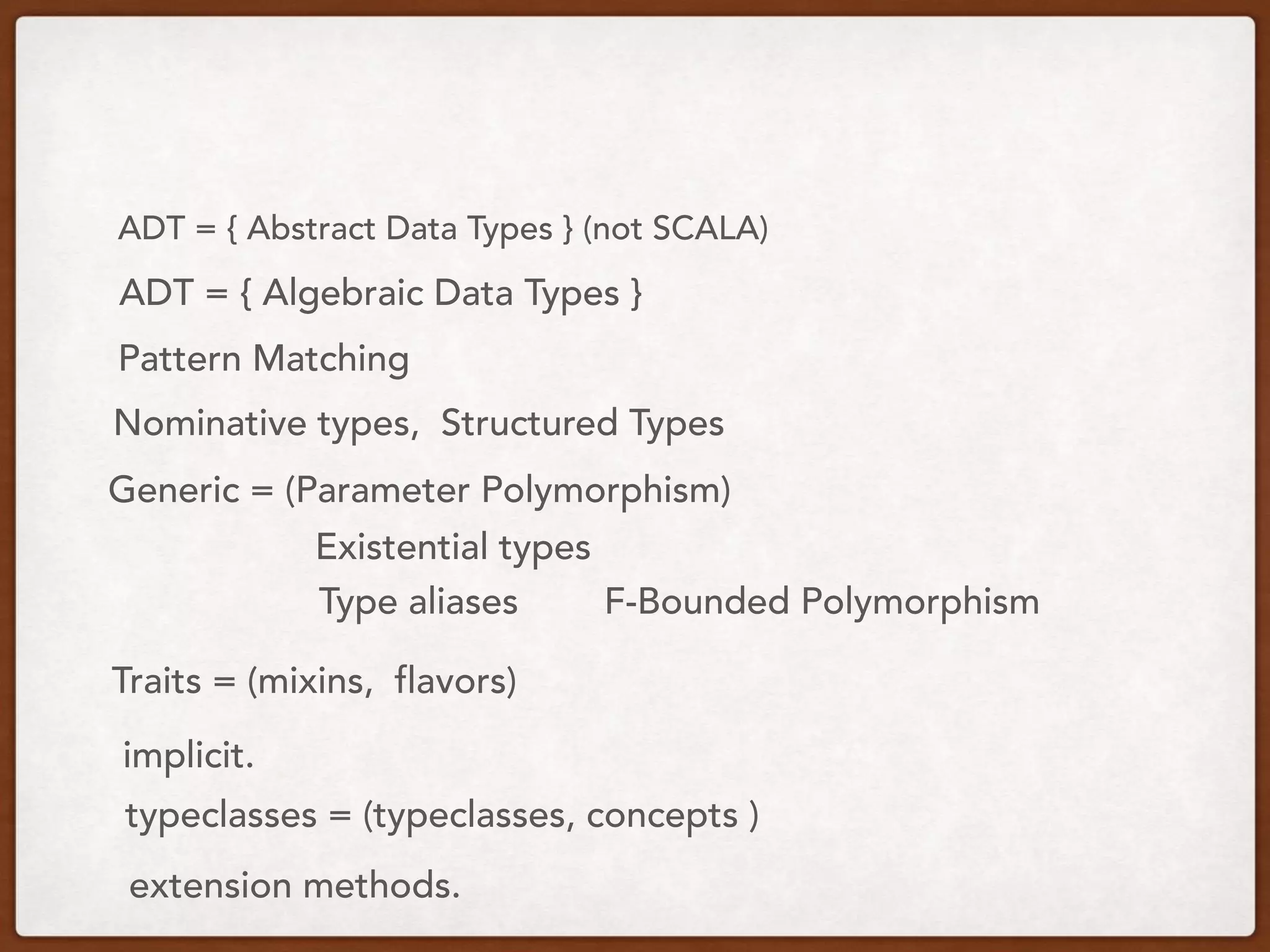
![ADT = { Abstract Data Types } (not SCALA)
CLU (1970, MIT)
"An abstract data type defines a class of abstract objects which is completely
characterized by the operations available on those objects. This means that an
abstract data type can be defined by defining the characterizing operations for
that type."
// 1974, ACM Sigplan, Congress of very hight-level languages.
From today-s point of view: Interface
cluster stack[t] is create push pop isEmpty
%rep struct {
arr: array[t]
idx: Int
}
create = proc() returns(cvt) ….
push = proc(x:t) signal(overflow)
trait Stack[T]
{
def push(x:T): Unit
…….
}
Barbara Leskov](https://image.slidesharecdn.com/scalajargoncheatsheet-160408113029/75/Scala-jargon-cheatsheet-5-2048.jpg)
![ADT = { Algebraic Data Type }
HOPE (1970, Edinburg)
From today-s point of view: ADT ;)
data list alpha = nil
++ alpha :: list alpha
(A, B) == Pair[A,B]
(A+B) == emulated by sealed trait
(a:A,b:B)== case classes.
A | B ~~ partially emulated by traits
(will be implemented in dotty)
A & B ~~ partially emulated by A with B
(will be implemented in dotty)
A => B == Function[A,B]
Rod Burstall
David MacQueen
Some initial set of types: A, B, C, ….
Operations on types: Pair [A*B]
records (set of name-value-pairs)
discriminated unions (one of A or B)
functions: A=>B
// often (incorrectly): discr. union == ADT
Equality by value](https://image.slidesharecdn.com/scalajargoncheatsheet-160408113029/75/Scala-jargon-cheatsheet-6-2048.jpg)
![ADT = { Algebraic Data Type }
data X = A ++ B
data A = ‘A#integer#integer
data B = ‘B#string
(a:A,b:B)== case classes [or objects].
sealed trait X
case class A(x:Int,y:Int) extends X
case class B(s:String) extends X
discriminated unions (one of A or B)
// often (incorrectly): discr. union == ADT
A+B
A+0
B+0
BOOL
BOOL
isA
isB](https://image.slidesharecdn.com/scalajargoncheatsheet-160408113029/75/Scala-jargon-cheatsheet-7-2048.jpg)
![Pattern Matching
HOPE (1970, Edinburg)
data list alpha = nil
++ alpha::list alpha
sealed trait List[+A]
class Nil extends List[Nothing]
class Cons[A](head:A, tail:List[A]) extends List[A]
Rod Burstall
David MacQueen
dec length: list(alpha) -> int
— length nil <= 0
— length (a::l) <= length(l) + 1
def length[A](l: List[A]): Int =
l match {
case Nil => 0
case Cons(head,tail) => 1+length(tail)
}](https://image.slidesharecdn.com/scalajargoncheatsheet-160408113029/75/Scala-jargon-cheatsheet-8-2048.jpg)
![Pattern Matching
SCALA
data list alpha = nil
++ alpha::list alpha
sealed trait List[+A]
class Nil extends List[Nothing]
class Cons[A](head:A, tail:List[A]) extends List[A]
dec length: list(alpha) -> int
— length nil <= 0
— length (a::l) <= length(l) + 1
def length[A](l: List[A]): Int =
l match {
case Nil => 0
case Cons(head,tail) => 1+length(tail)
}](https://image.slidesharecdn.com/scalajargoncheatsheet-160408113029/75/Scala-jargon-cheatsheet-9-2048.jpg)
![Pattern Matching
SCALA
data list alpha = nil
++ alpha::list alpha
sealed trait List[+A]
class Nil extends List[Nothing]
class Cons[A](head:A, tail:List[A]) extends List[A]
dec length: list(alpha) -> int
— length nil <= 0
— length (a::l) <= length(l) + 1
def length[A](l: List[A]): Int =
l match {
case Nil => 0
case head :: tail => 1+length(tail)
}](https://image.slidesharecdn.com/scalajargoncheatsheet-160408113029/75/Scala-jargon-cheatsheet-10-2048.jpg)
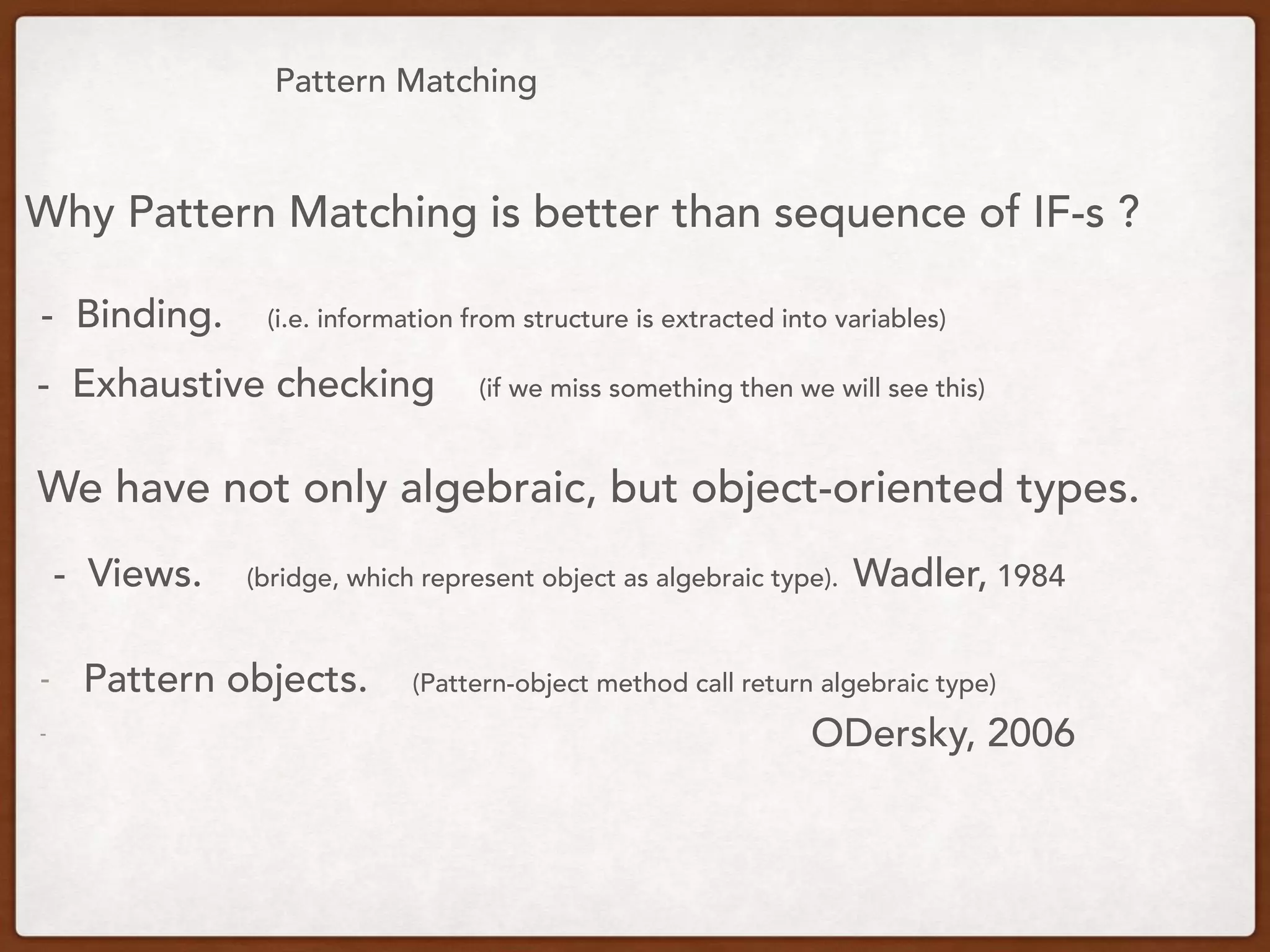
![x match {
case A(x,y) => y1
….
}
We have not only algebraic, but object-oriented types.
Pattern-Object
object A {
def unapply(x: X): Option[(A,B)]
}
extractor
Regular expressions:
final val StackElement =
“""W+([^)]+)(([^:]*):([^)]*))W*""".r
line match {
case StackElement(class,file,lineno) => ….
….
}
sealed trait Option[+A]
case class Some[A](a:A) extends Option[A]
case object None extends Option[Nothing]](https://image.slidesharecdn.com/scalajargoncheatsheet-160408113029/75/Scala-jargon-cheatsheet-12-2048.jpg)
![val fac: Int => Int = {
case 0 => 1
case n => n*fac(n-1)
}
Partial functions syntax:
object Succ
{
def unapply(n: Int):Option[Int] =
if (n==0) None
else Some(n-1)
}
{ case (x,y) => (y,x) }
val positiveOne: Int => Int = {
case Succ(n) => 1
}
positiveOne.isDefinedAt(0)
false
positiveOne.isDefinedAt(3)
true](https://image.slidesharecdn.com/scalajargoncheatsheet-160408113029/75/Scala-jargon-cheatsheet-13-2048.jpg)
![Partial functions:
val positiveOne: Int => Int = {
case Succ(n) => 1
}
positiveOne.isDefinedAt(0)
false
positiveOne.isDefinedAt(3)
true
PartialFunction[A,B]
B
Boolean
A
apply
isDefinedAt](https://image.slidesharecdn.com/scalajargoncheatsheet-160408113029/75/Scala-jargon-cheatsheet-14-2048.jpg)
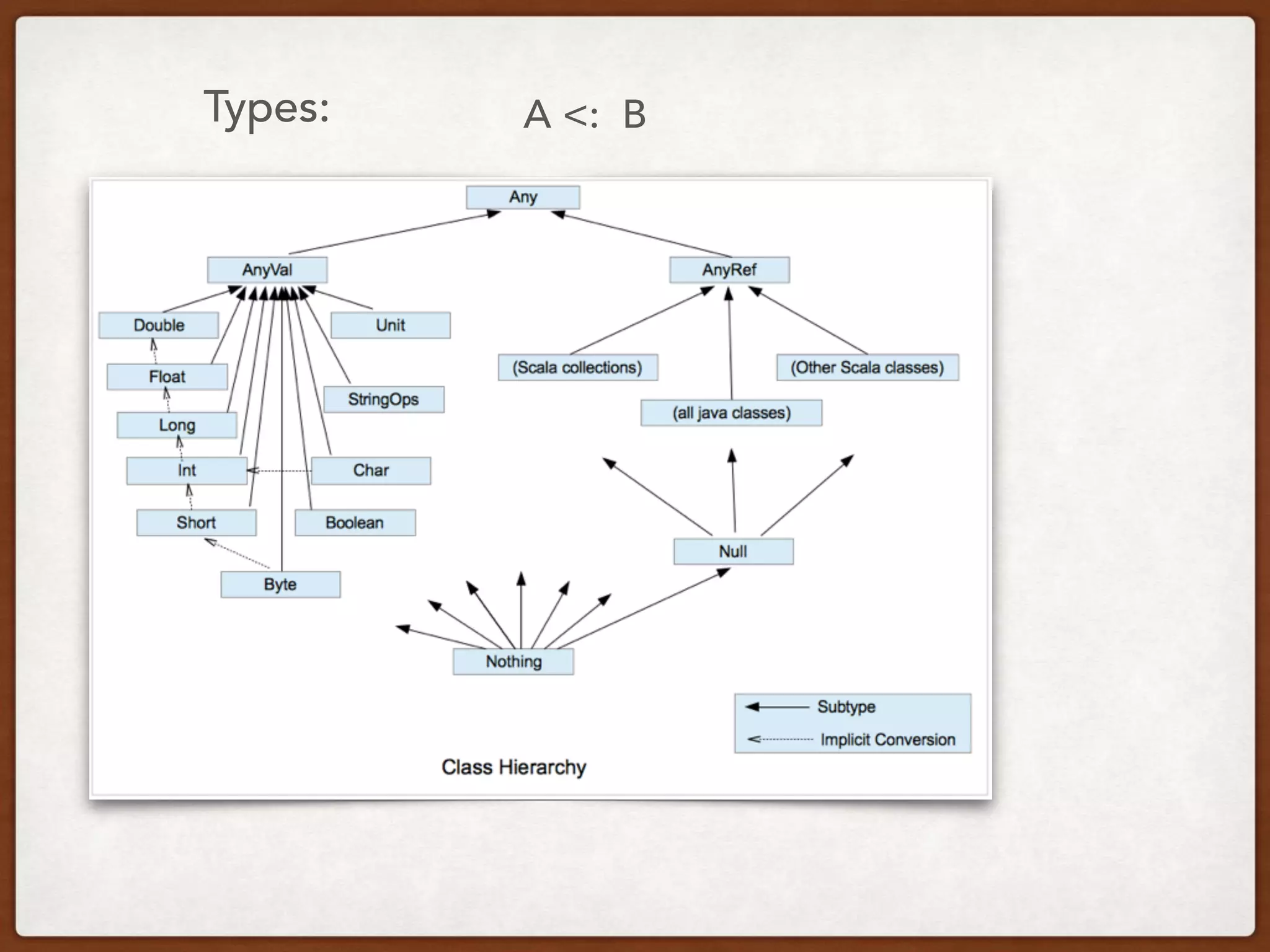
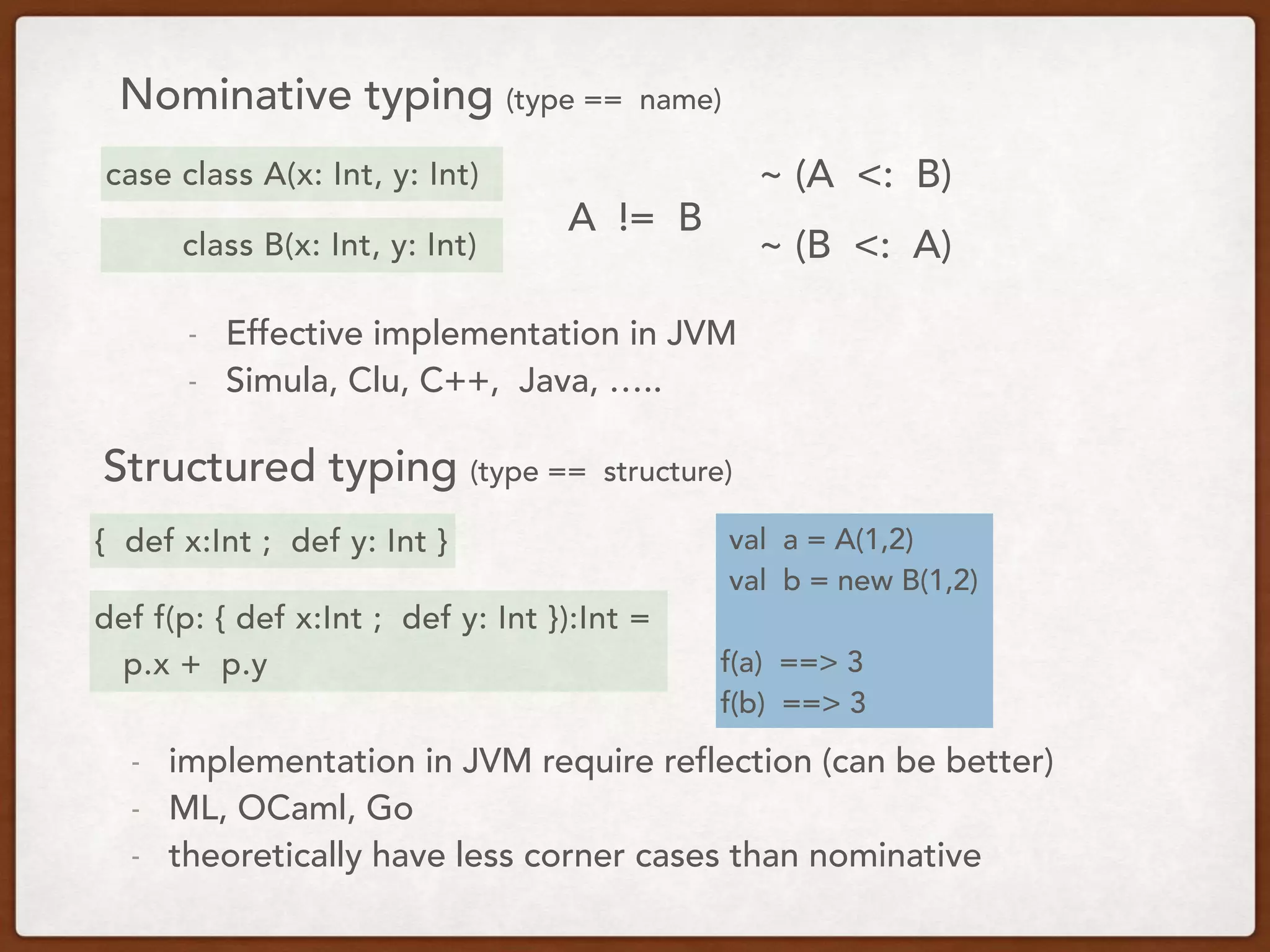
![Refined type
Generics [Parametric Polymorphism]
B {
def z: Int
}
F[T]
- Structured type, based on nominative.
- Scala: structured types are refinement of AnyRef
Existential types: F[_] F[X] for Some X
Bounded type parameters:
Type aliases
F[T <: Closeable]
F[T <: { def close(): Unit }]
trait Expression[A]
{
type Value = A
}
trait Expression
{
type Value <: X
}
Undefined type alias
Scolem type
//CLU where](https://image.slidesharecdn.com/scalajargoncheatsheet-160408113029/75/Scala-jargon-cheatsheet-17-2048.jpg)
![Traits:
trait Interpeter {
type Value
}
trait BaseInterpreter[A] extends Additive with Multiplicative with Show
{
type Value = A
}
Flavours (Flavours, [LISP dialects]) 1980, MIT
Mixing
trait Show {
this: Interpreter =>
def show
}
trait Additive {
this: Interpreter =>
def plus(x:Value, y:Value): Value
}
// Howard Cannon, David Moor
(CLOS, OCaml, Groovy, Python ..)](https://image.slidesharecdn.com/scalajargoncheatsheet-160408113029/75/Scala-jargon-cheatsheet-18-2048.jpg)
![Traits:
trait LoggedInterpreter[A] extends BaseInterpreter[A]
with Logged with LoggedAdditive
trait LoggedAdditive extends Additive {
this => Logged
def plus(x:Value, y: Value) : Value =
{
log(s”(${x}+${y}”)
super.plus(x,y)
}
}
trait Additive {
this: Interpreter =>
def plus(x:Value, y:Value): Value
}
// AOP (aspect oriented programming)
// Flavours
: around
: before-next
: after-next](https://image.slidesharecdn.com/scalajargoncheatsheet-160408113029/75/Scala-jargon-cheatsheet-19-2048.jpg)

![Type classes.
trait Eq[A] {
def === (x:A, y:A):Boolean
def !== (x:A, y:A):Boolean = !(x===y)
}
trait Ord[A] extends Eq[A]
{
def compare :: a->a->Int
override
def ===(x:A, y:A):Boolean =
(compare(x,y)==0)
}
implicit val intOrd: Ord[Int] = new Ord[Int]
{
def compare(x:Int, y:Int) = (x-y)
}
//in scala as design pattern (implicit) & one word
implicit def pairEq[A,B]: Eq[Pair[A,B]]
( implicit eqA:Eq[A], eqB:Eq[B]) =
{
def ===(x: Pair[A,B],y:Pair[A,B]):Boolean=
eqA(x._1,y._1) && eqB(x._1, y._1)
}](https://image.slidesharecdn.com/scalajargoncheatsheet-160408113029/75/Scala-jargon-cheatsheet-21-2048.jpg)
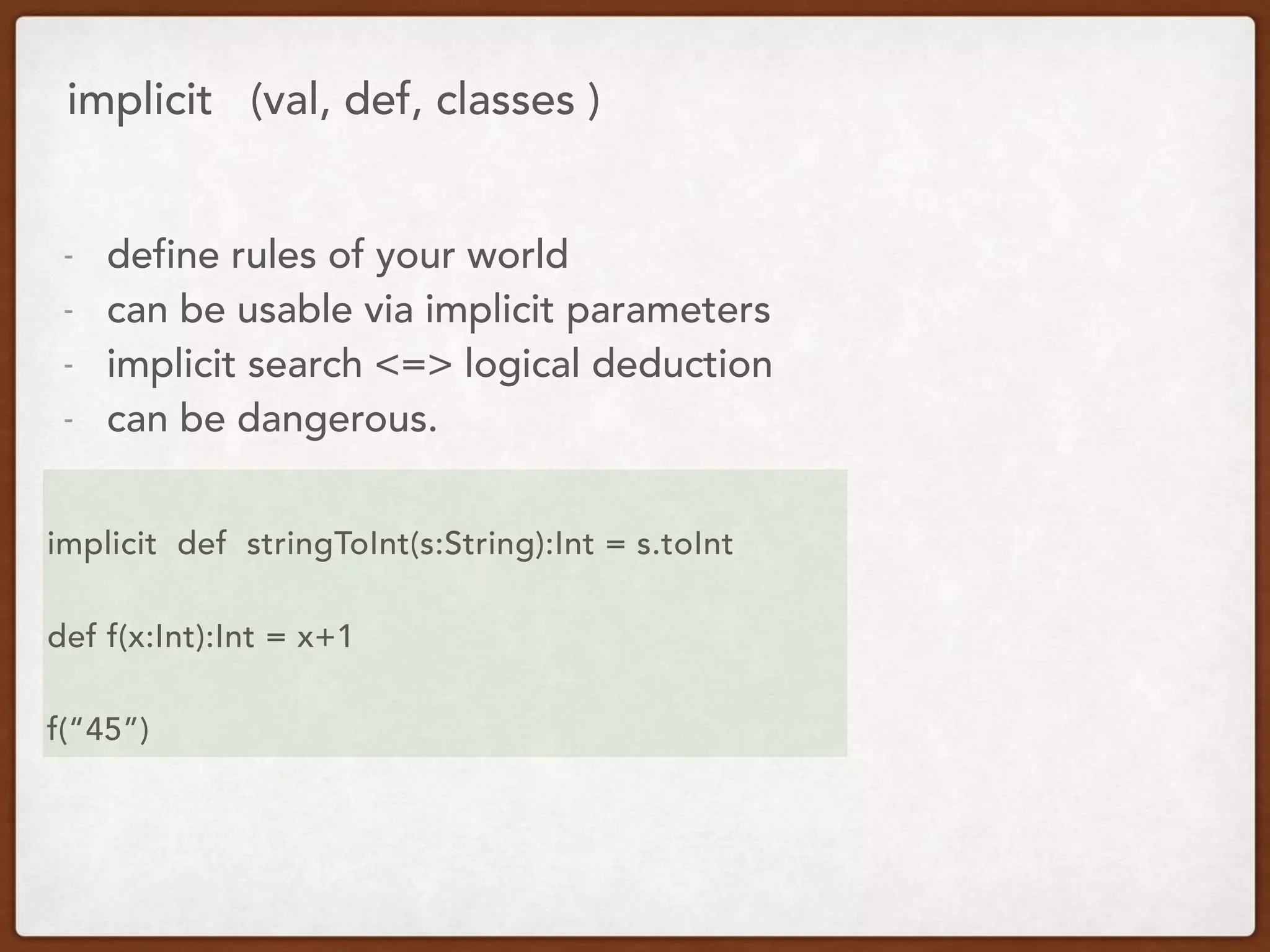
(implicit convert:A=>Json): String =
convert(x).prettyPrint](https://image.slidesharecdn.com/scalajargoncheatsheet-160408113029/75/Scala-jargon-cheatsheet-23-2048.jpg)
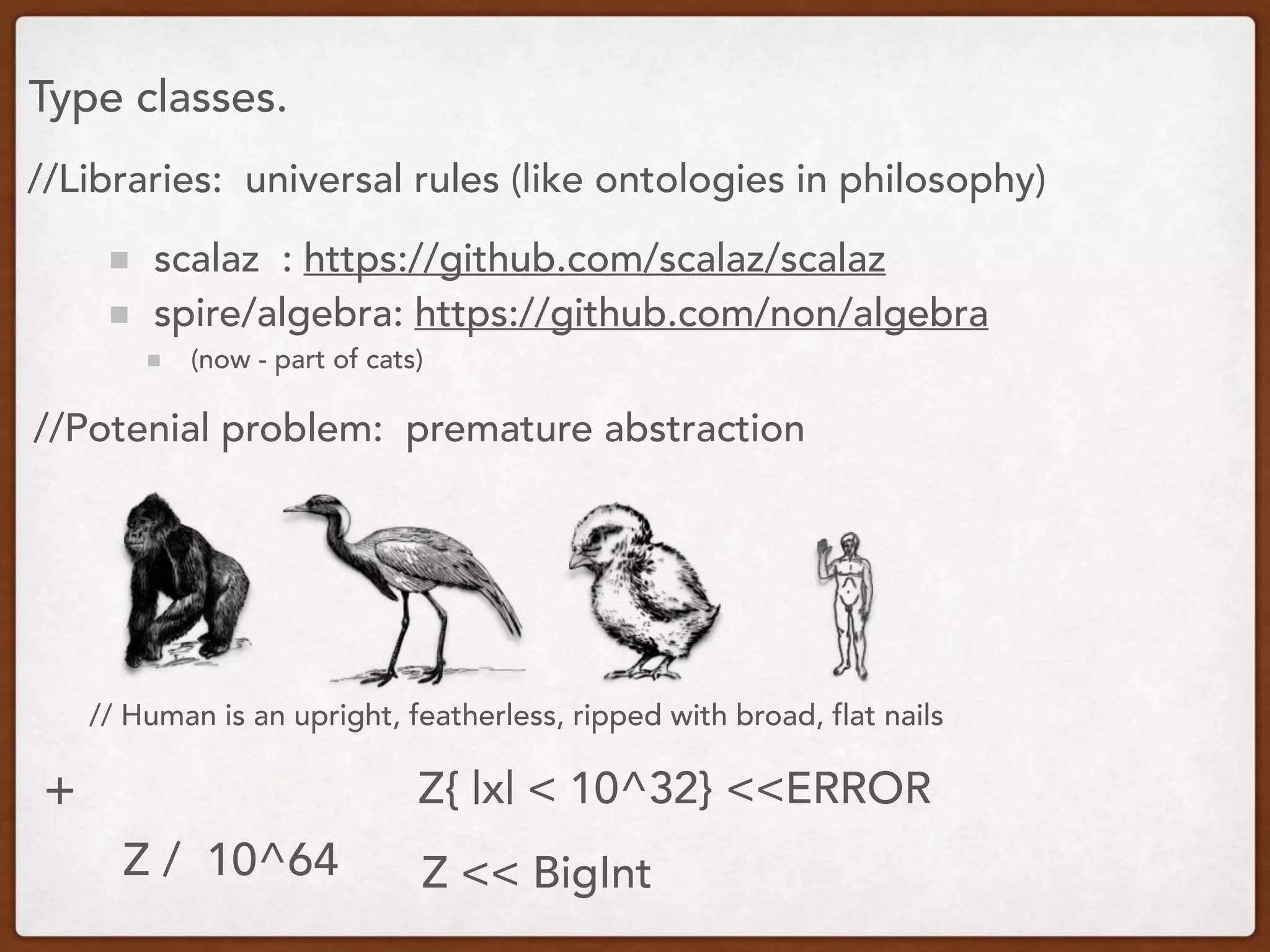
![Extension methods.
//implicit-based technique (pimp my library pattern [obsolete name])
implicit class WithPow(x: Int) {
def pow(y: Int): Int = Math.pow(x,y).toInt
}
scala> 2 pow 3
scala> res1: Int = 8
• pow — Int have no pow method
• => compiler search for implicit with pow](https://image.slidesharecdn.com/scalajargoncheatsheet-160408113029/75/Scala-jargon-cheatsheet-25-2048.jpg)
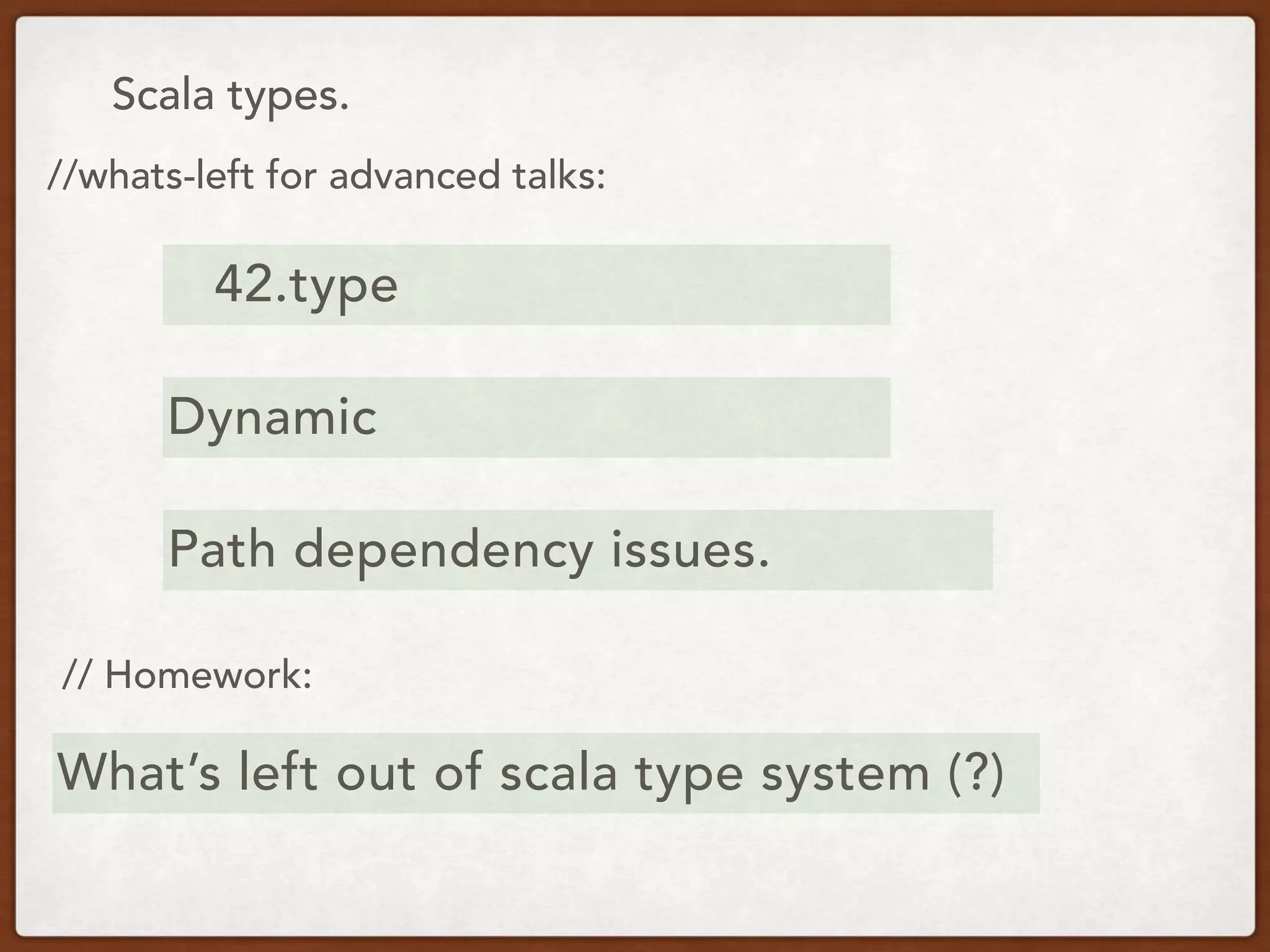
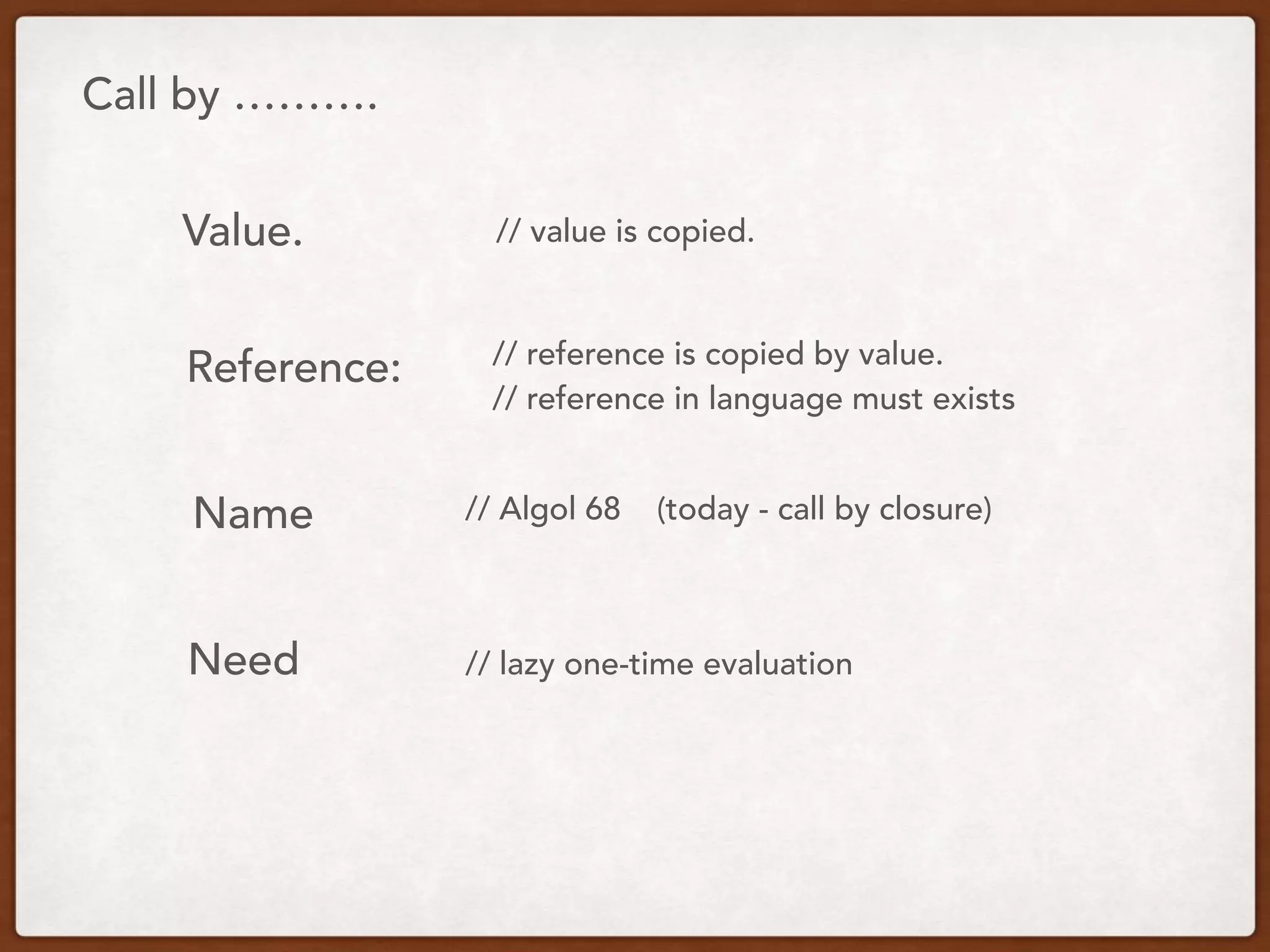
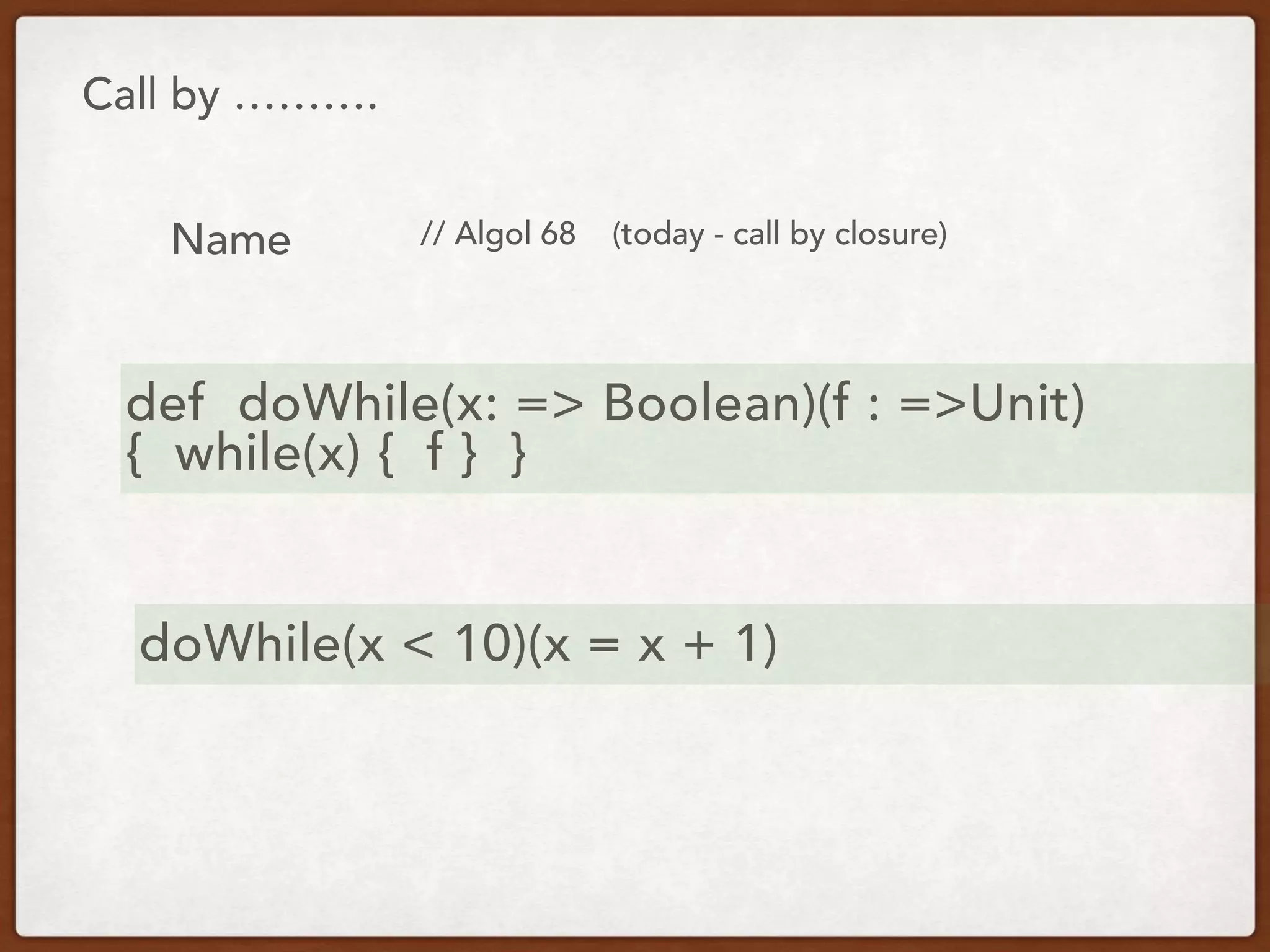
: Seq[A] =
{ lazy val neededV = v
for( i <- 1 to N) yield v
}](https://image.slidesharecdn.com/scalajargoncheatsheet-160408113029/75/Scala-jargon-cheatsheet-29-2048.jpg)
